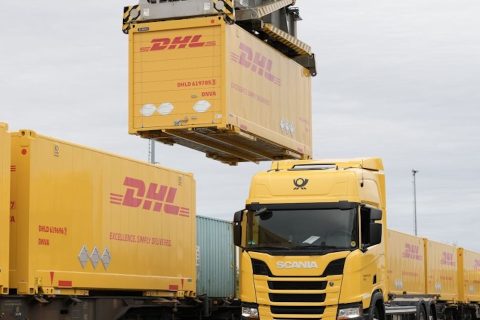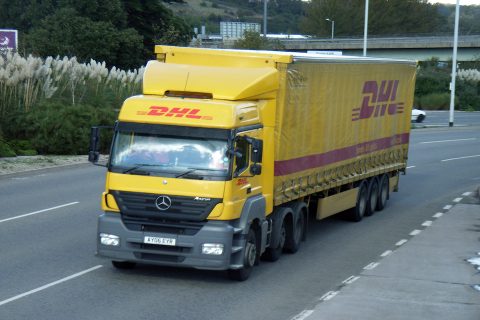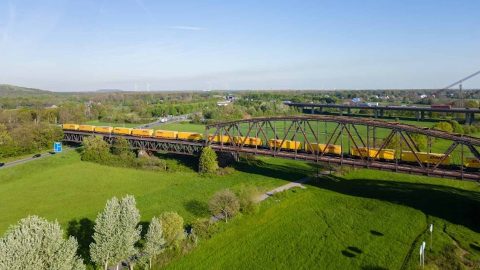
Logistics courier concedes road-rail conflict model is outdated
Global courier company DHL has recognised the value of rail freight as part of the overall logistics chain. However, their latest study emphasises conflict, not collaboration, between the two modes of land transport. Although concentrating on European operations, the language of the report suggests an American influence, where the short and mid-length haul market is heavily based on road transport.
The report from DHL examines the comparative merits of road and rail logistics. “Road Transport vs Rail Transport – Head-to-Head Comparison”, just published by the logistics giant, looks at the technical impact of operations and makes reference to the impact of ground terminal infrastructure – suggesting that rail may actually have the environmental edge and encourages operators to consider the intermodal train as a rolling warehouse.
Infrastructure issues after rail market appeal
Transport costs are generally higher on rail than on road, argue DHL. That’s no surprise, given that the Bonn-headquartered, American-founded carrier is best known for their bright yellow road trucks. “There can be several reasons for this, including a higher wage structure in the rail sector or train path prices – compared with road tolls, charges for track use are usually higher. These two factors result in higher freight rates for rail freight compared to road freight.” However, although clearly looking at the intermodal market, the report also claims that for high transport volumes, as well as long transport routes, “rail occasionally can also score in terms of price”. UK operators handling bulk aggregates loads may take issue with that finding.

The report does not shy away from the limitations of rail freight logistics. In a statement that perhaps reflects the commercial focus of DHL, is says rail traffic provides a certain degree of predictability because it is based on timetables. “However, anyone who has ever traveled by rail knows that a single delayed train can upset the entire timetable. It is no different in rail freight. So thanks to timetables, long-term planning is good in theory. In practice, a train can get stuck on the tracks just as a truck in a traffic jam. This is often due to inadequate infrastructure, which lags behind demand in almost all of Europe. Rail freight requires less surface area for transporting the same amount of goods. This advantage is nullified if the infrastructure is not up to the demand or is outdated: switches fail, signals are disrupted, and even in the digital age, wagons are still coupled manually in many places.”
Road development better, rail security tighter?
Truckers driving through Britain’s potholed highways, and observing graffiti vandalised bulk trains passing nearby may argue that the roads could do with far better development and security on the railways is demonstrably lacking. However, DHL conclude that although many roads and road bridges in Europe are ailing, the road network as a whole is better developed and more branched out,“usually right up to the doorstep of the consignee”, they say. “In contrast, only a few large companies have their own rail sidings. This means for door-to-door deliveries, in most cases, they are only possible if the truck is integrated into the transport chain.

Looking at security in the terms of loads, the report says rail wins, hands down. “In truck traffic, the probability of an accident is about 40 times higher than on rail, [and] the risk of a total loss is higher on the road. The consignor has thus a lower risk of failure when using rail”, says DHL. “In addition, the risk of theft is lower in rail freight. It is more difficult to approach and unload a railway wagon than a parked truck left unattended.” That though, is not necessarily a statement that stands up back in California, from where DHL, now a German company, can trace its roots.
Best of both worlds
The report concludes that flexibility is the ace in the hand for trucking to trump over rail. “The greatest asset of road freight, apart from the possibility of door-to-door delivery, is its flexibility”, they say. “Of all means of transport, the truck offers the greatest flexibility, both in terms of time and location. In addition, a truck can take over a tour at short notice and leave from almost any place and at any time. A freight train must always adhere to the timetable and is not suitable for spontaneous deliveries. The train is inflexible in two respects: time-wise, because of the schedule, and space-wise, because it is dependent on the poorly developed rail network.”

The land freight of the future is likely to be the combination of the advantages of both modes of transport, especially for intermodal transport. “The train takes over the long haul, and before and after that the truck covers the first and last kilometres. “This is indeed often the case today if the delivery point is not connected to the rail network. In such cases, transport logistics was already intermodal even 100 years ago – but probably without calling it this way. For the future, the expansion of intermodal concepts implies that considerably more tons of long-distance freight will be shifted to rail to relieve the burden on the roads and the environment.”



